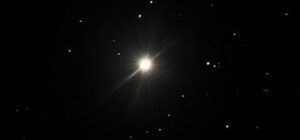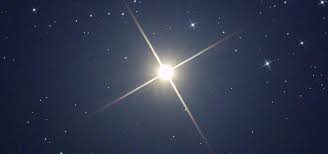
What Is That Bright Light In The Sky After Sunset?; As twilight descends and the sun dips below the horizon, a bright light often catches our attention in the evening sky.
This phenomenon has intrigued humans for centuries and sparked curiosity, myths, and scientific inquiry. But what is this luminous object that shines so brightly after sunset? Let’s delve into its identity, origins, and the science behind its brilliance.
READ THIS POST: Nuclear Electric Propulsion Technology: Making Mars Missions Faster
The Evening Star: Venus
What Is That Bright Light In The Sky After Sunset?; The most common answer to the question is Venus, often referred to as the “Evening Star” or the “Morning Star” due to its striking visibility shortly after sunset or before sunrise.
Venus is the second planet from the Sun and one of the brightest objects in the sky, second only to the Sun and the Moon.
Its brightness is due to several factors:
- Proximity to Earth: Venus is one of Earth’s closest planetary neighbors, and its relative proximity makes it appear larger and brighter than most other celestial objects.
- Highly Reflective Atmosphere: Venus’s atmosphere is composed mostly of carbon dioxide with thick clouds of sulfuric acid. These clouds reflect sunlight very efficiently, giving Venus its dazzling brilliance.
- Position in Orbit: Venus’s orbit places it closer to the Sun than Earth, which means we see it during specific phases of its orbit when it is most illuminated from our perspective.
Venus appears as a steady, non-twinkling light due to its proximity and size, unlike stars which twinkle because their light passes through Earth’s turbulent atmosphere.
Other Possible Objects In The Sky
While Venus is the most likely culprit, other objects in the sky can also shine brightly after sunset under certain conditions. These include:
1. Jupiter
What Is That Bright Light In The Sky After Sunset?; Jupiter, the largest planet in our solar system, can also appear exceptionally bright in the evening sky.
Unlike Venus, Jupiter’s brightness stems from its enormous size and the reflective properties of its cloud tops. When it is in opposition (directly opposite the Sun from Earth’s perspective), Jupiter’s visibility increases, making it a standout object in the night sky.
2. Saturn
Saturn, known for its iconic rings, can also be a bright light in the sky. Though not as luminous as Venus or Jupiter, Saturn’s visibility increases when it is in opposition.
3. The International Space Station (ISS)
What Is That Bright Light In The Sky After Sunset?; The ISS is another source of bright light after sunset. Orbiting Earth at an altitude of about 400 kilometers, the ISS reflects sunlight, making it visible as a bright, fast-moving object in the sky. Unlike planets, the ISS moves quickly across the sky, often disappearing as it enters Earth’s shadow.
4. Bright Stars
Some stars, such as Sirius (the brightest star in the night sky), can appear prominently after sunset. Sirius is part of the constellation Canis Major and is notable for its intense brightness and bluish-white color.
How to Identify the Object In The Sky
To determine what the bright light in the sky might be, consider the following factors:
- Time of Year: The visibility of planets changes throughout the year due to their orbits. For instance, Venus is most visible during its elongation, when it appears farthest from the Sun in our sky.
- Twinkling vs. Steady Light: Stars twinkle due to atmospheric turbulence, while planets and artificial satellites shine with a steady light.
- Color: The color of the light can provide clues. Venus and Jupiter appear white or yellowish, Mars has a reddish hue, and Sirius often displays a bluish-white color.
- Movement: Satellites like the ISS move steadily across the sky, while stars and planets remain fixed relative to each other.
- Astronomy Apps and Tools: Apps like Stellarium or SkySafari can help identify celestial objects by pointing your phone at the sky.
READ THIS ARTICLE ALSO: History Made as Webb Telescope Finds 44 Stars Near Big Bang: Find Out How It Did It
The Role of Astronomy in Understanding Bright Lights
What Is That Bright Light In The Sky After Sunset?; Astronomy provides us with tools and frameworks to comprehend the phenomena we observe in the sky.
Here’s how:
- Celestial Mechanics: Understanding the orbits of planets, moons, and artificial satellites helps explain their positions in the sky.
- Light Reflection and Absorption: The study of albedo (reflectivity) explains why some objects, like Venus, appear brighter than others.
- Spectroscopy: Analyzing the light from celestial objects reveals their composition, temperature, and movement.
Historical and Cultural Significance of bright Light in the Sky
The bright light of Venus and other celestial objects has captivated humanity for millennia, influencing cultures, religions, and science.
- Ancient Civilizations: Many cultures revered Venus. The ancient Mayans tracked its movements with remarkable precision, while the Romans associated it with the goddess Venus, symbolizing love and beauty.
- Mythology: Venus was often considered a harbinger of change, signaling the dawn or dusk.
- Navigation: Bright celestial objects like Venus and stars such as Polaris have historically aided navigation.
Modern-Day Implications Of The Bright Light In The Sky
What Is That Bright Light In The Sky After Sunset?; In today’s world, the bright lights in the sky inspire scientific exploration and public fascination.
Here are some modern implications:
- Space Exploration: Bright planets like Venus and Mars are prime targets for exploration. NASA’s missions to Venus aim to understand its extreme atmosphere, while Mars rovers search for signs of past life.
- Citizen Science: Amateur astronomers contribute to the study of celestial events, tracking objects like satellites, meteors, and planetary alignments.
- Educational Outreach: Observing bright objects in the sky serves as an entry point for learning about astronomy, physics, and space science.
FAQs About Bright Lights After Sunset
1. Why does Venus sometimes disappear? Venus’s visibility depends on its orbit. When it is on the far side of the Sun relative to Earth, it becomes obscured by the Sun’s glare.
2. Can Venus be seen all year round? No, Venus’s appearance as the Evening or Morning Star alternates due to its orbit around the Sun.
3. Why does Venus appear brighter than Jupiter? Although Jupiter is larger, Venus is closer to Earth and has a higher albedo, making it appear brighter.
4. Can I see the ISS without a telescope? Yes, the ISS is visible to the naked eye as a bright, fast-moving object under the right conditions.
Conclusion
The bright light in the sky after sunset is most often Venus, a celestial beacon that has fascinated observers for centuries. However, other possibilities include Jupiter, Mars, Saturn, the ISS, or even bright stars like Sirius.
By considering factors such as brightness, color, and movement, you can identify the object and deepen your appreciation for the wonders of the universe.
Observing these lights reminds us of the intricate dance of celestial bodies and the enduring human quest to understand our place in the cosmos.
